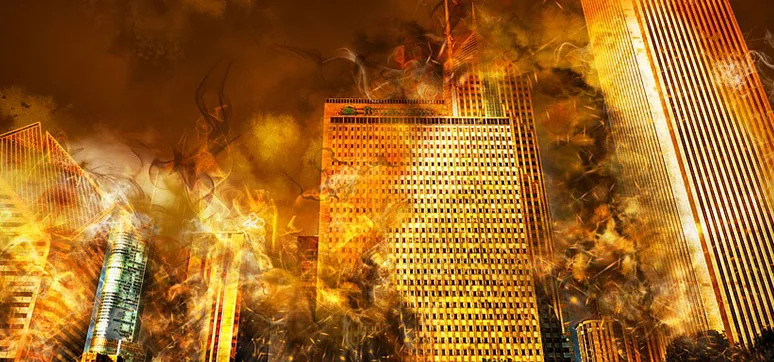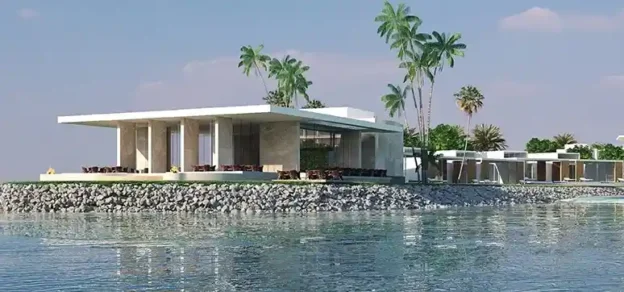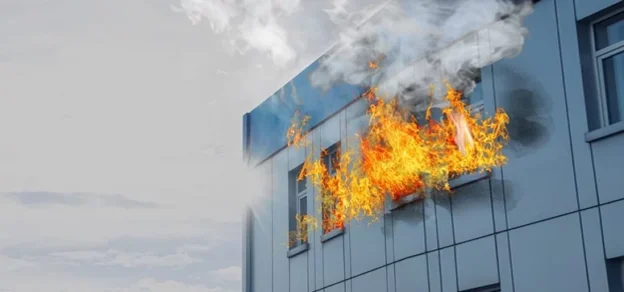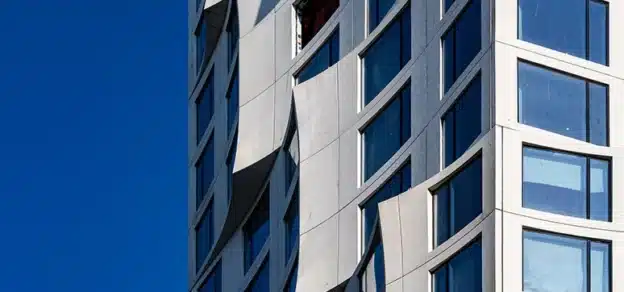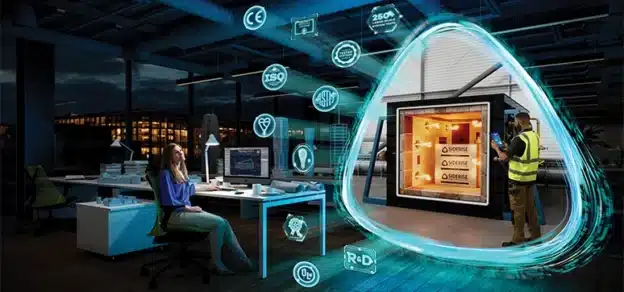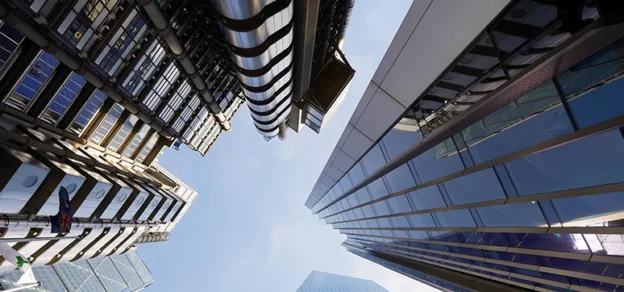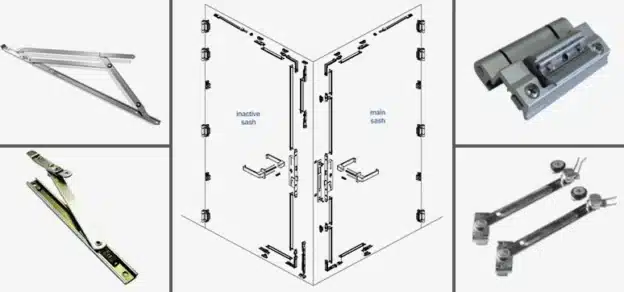In any building, fire safety is of the utmost significance. Fire safety should always be taken seriously, and there are many simple techniques to minimize the risk of a fire. The design stage is where fire safety for façades begins. The architect, in collaboration with the other technical disciplines, should guarantee that the design aesthetic intent is met while maintaining the requisite technical performance. The usage of fire-safe products and technology is critical. Extensive research and testing are frequently used to develop these items and technologies. Each component of the façade system should be tested for fire resistance.
In this cover story, the views and suggestions of subject-matter experts are presented. We tried to get their opinions on façade fire safety, the codes & regulations, the suitable materials, the right way to design the façade to make it fire-safe, and so on.
Common causes for fires in Buildings in the Middle East

There are a number of reasons why fires start in buildings, i.e. shortage in electrical circuits, gas (barbecue), smoking, and hot-work, says Stefan- Gerald Renner, Regional Manager, SVT Middle East FZE. The most common in the Middle East is the human factor: either accidentally, poor craftsmanship, or caused by ignoring certain standards regarding fire safety. Fire security measurements are mostly victims of the so-called “Value Engineering”, which in this area of the world has a different meaning. It is important to understand that this is the wrong place to save money, we talk here about human life, and in the unexpected event of a fire, it will get even more expensive. We should actually invest more in fire protection rather than cutting costs.
He adds experience shows that fire outbreaks can be expected at any time. The fact that fire has not occurred in many buildings for decades does not prove that there is no danger. It is only a stroke of luck, whose end may arrive by any chance. That means that a fire outbreak can happen anywhere and anytime, but then the building must be prepared to stop the spread of fire. The most important risk-reducing method is correctly built and sealed compartment walls, correctly fitted fire doors, correctly sealed pipes, cables, and ducts, correctly sealed floor slabs, and the use of correct façade materials and compartmentation of the façade. Summed in other words – passive fire protection.

Managing Partner – Principal Consultant Fire & Life Safety,
SHE Fire Safety Consultancy
According to Raja Sajad Hussain, Managing Partner – Principal Consultant Fire and Life Safety, SHE Fire Safety Consultancy, cigarette butts, ill-maintained or faulty air conditioners, poor electrical connections and extensions, and fake electrical appliances are the leading causes of fire accidents. Fire incidents in commercial and industrial establishments are also caused by improper storing of goods and inflammable materials.
Carelessly discarding cigarette butts should be avoided. One should choose and install good-quality electrical connections and avoid using substandard extensions. Loading them with energy higher than their capacity can also trigger ablaze. With the advent of winter when residents use water heaters in bathrooms, explosions and fire accidents increase. To avoid any mishap residents must not put on the water heaters for long hours.

Engineering, Design Confidence Consultancy, Dubai
Anam Asad, Senior Associate – Fire Engineering, Design Confidence Consultancy – Dubai believes that the common causes of fires in the region include cooking equipment, electrical, smoking, and candles. Cooking unattended in the kitchen is considered to be the most common of all in homes and apartments. Electrical fires are also very common and have increased with the use of electrical equipment. Within the USA alone, 10% of the reported home structure fire between 2014 and 2018 are linked to an electricity-related fire hazard. Lighted cigars, cigarettes, and other smoking materials can start fires if disposed of improperly. These are also responsible for almost 9% of the reported office fires. The common causes of façade or cladding fire are generally fire from external ignition sources such as improperly disposed of garbage, burning charcoal, cigarettes, etc. Other sources include the welding sparks from maintenance works near the combustible cladding or sheesha coal left on the balcony.
The fire risks can be reduced by implementing a combination of measures including engineering controls such as adopting fire-safe designs, adopting fire-safe materials, and adopting fire-safe installation, and administrative controls such as controlling the ignition sources in and around the building.

Kaushik, Senior Fire Consultant, Vortex Fire
The two most common causes of fires in the Middle East are faulty wiring leading to electrical short circuits and carelessly discarding cigarette butts, opines Padmanabhan Kaushik, Senior Fire Consultant, Vortex Fire. A fire source coupled with improper fire safety design in a building could lead to a major fire accident. To reduce fire risk, it is imperative that the building design complies with the statutory and regulatory requirements. Once constructed, the building management or operator shall implement a comprehensive emergency response plan with a pyramid of training, drills, and exercises that are needed to educate all the occupants about their roles and responsibilities. Further, during the lifetime of the building, it is important to carry out fire safety audits at regular intervals to ensure that fire risk is kept as low as reasonably practicable.
Role of Design Systems in Fire-Safe Buildings
Stefan opines that a correctly designed passive fire protection concept will stop the spread of a fire by creating fire-resistive compartments/sections within the building. This allows residents to escape the building, keep the fire outbreak limited to a certain area, and allow fire departments to arrive and extinguish the fire without major obstacles. Howsoever, the role of façades in fire has been unclear, and globally. Following the Grenfell London fire, which caused dramatic and unnecessary fatalities, a clear-cut role emerged: Façades must also protect occupants by preventing the fire from spreading to the interior of buildings, therefore compartmentation of façades is a design key.
Raja opines that the buildings need to be designed to offer an acceptable level of fire safety and minimize the risks. Fire safety design can help to reduce fire spread and contain smoke and property damage. It also means safer buildings for all end users. The fire safety strategy forms an integral part of the design and must be integrated from the point at which a building project is identified.
The main design options to ensure fire safety are:
- Prevention: Controlling ignition and fuel sources so that fires do not start.
- Communications: If ignition occurs, ensure active fire systems are triggered and occupants are informed immediately.
- Containment: Ensuring fire is contained to the smallest possible area.
- Extinguishment: Ensuring that fire can be extinguished quickly.
- Escape: Ensuring that occupants of buildings are able to move to safer places.
– Raja Sajad Hussain, Managing Partner – Principal Consultant Fire and Life Safety, SHE Fire Safety Consultancy
Anam opines that a fire-safe building highly relies on a fire-safe design and adopting the right design systems to meet fire safety goals and objectives. A fire-safe design can help improve the safety of fire for the occupants immediately after the fire, save the occupants who are away from the fire, reduce structure, and limit smoke damage to a smaller portion of the building. All of these design measures greatly help towards achieving the fire safety goals and objectives of the code/ owner/ operator. The design measures include both active and passive measures to prevent, suppress, and control the fire in a fire area thereby allowing the occupants to evacuate to the point of fire safety in a safe manner. The measures include adopting a sprinkler suppression system, automatic smoke ventilation, cavity barriers, limited combustible materials, etc.

Kaushik urges that fire safety must form an integral part of the building design right from the planning stages. All project stakeholders are responsible for the fire safety of a building. All parties must actively collaborate from the planning stage up to the building handover to ensure a fire-safe environment is provided to the building occupants. History has shown that improper fire safety design could lead to fatalities during a fire and is extremely expensive for the owners to rectify the design and get the building back in operation.
Role of Fenestration Design in Fire-Safe Buildings Here we have also to consider a correct design and the use of the right materials/systems to prevent the escalation of fire spread. The fenestration has to bear two functions: a) design and b) performance. Sometimes these two functions don’t go hand in hand, and this is when consultants have to decide what is more important, says Stefan.
Raja believes that fenestration is an integral part of façade design and refers to openings, such as windows, doors, and skylights in the building envelope. It plays an important role in assuring the fire safety of a building. Fires can originate internally and spread to the exterior façade through openings on the exterior walls such as doors, windows, and shattered glazing because of flashover.
Anam opines that fenestration plays an important role in the overall aesthetics or the performance and hence a fire-safe design of fenestration is highly important towards achieving the fire safety objects of the buildings. Fenestrations are the arrangement and design of the windows, doors, skylights, and other glazed elements of the buildings. There are multiple fenestrations design options and product options available in the market. Based on the fire strategy of the project, the selection and installation of the correct option can greatly help in reducing the external fire spread from one building to another and or within different levels of the building.
Kaushik says fenestrations or window and door openings on the façade play a significant role in the fire safety of the building and its façade. Fenestrations provide a pathway to the flames to the exterior walls and cavities. Installing cavity fire barriers around the openings can restrict the flame and smoke spread from the building interior to the cavity space.
Passive and Active Fire-Safe Protection Methods Stefan says passive fire protection should stop the spread of fire and keep the impact limited to a certain area. Active – like a fire sprinkler – is to suppress and extinguish the fire. Unfortunately, sprinklers require annual service and maintenance, and statistics show that this is a common cause of failure. Other active installations are fire alarm systems that warn residents and allow them to escape. There is nothing worse than an escape route under fire and smoke. Even clearly signed and easy-to-access portable fire extinguishers could already help to stop a major outbreak.
According to Raja, passive fire protection and active fire protection perform fundamentally different tasks that are equally important. Passive fire protection refers to fire resistance measures that are all about preventing the spread of flame and resisting ignition in the first place and requires no action to work. This resistance is generally structural and designed to compartmentalize a building and isolate a flame by using fire resistance walls and floors. Examples of passive fire protection are fire doors, firewalls, fire floors, dampers, fireproofing sprays, and paints.
He adds active fire protection on the other hand takes action in order to put out a fire. Active fire protection refers to systems that involve a triggered response to a fire. Active systems are initiated by the flame or smoke and the response may be manual like using a hand-operated fire extinguisher or automatic like a sprinkler system or gaseous fire suppression system. Examples of active fire protection systems are fire extinguishers, fire hose reels, fire blankets, sprinkler systems, smoke alarms, etc.
Both active and passive fire protection measures are required in combination within the building to achieve the objectives of fire spread, says Anam. Passive fire protection divides the buildings into fire compartments both vertically and horizontally which helps to limit the fire to the given compartment for a certain duration. This approach provides enough time for the building occupants to evacuate safely and for the firefighters to control and extinguish the fire. Whereas active fire suppression systems focus on suppressing the fire or extinguishing fires. The active fire protection systems can be manual or automatic. The system generally includes detection, suppression, and ventilation.
Kaushik describes active fire protection systems help in detecting and suppressing a fire; whereas passive fire protection systems help in containing the fire spread within the building. Some examples of active fire protection systems are fire detection & alarm system, fire sprinkler system, standpipes, etc. Examples of passive fire protection systems include compartmentation, fire doors, fire stopping, etc. When designed correctly, the two systems work together to alert occupants of the building and contain the fire so that the occupants can evacuate quickly and safely.

Reaction and Fire Resistance: Classification of Materials in the Event of a Fire
Stefan explains one can easily differentiate the reaction between combustible and incombustible materials. Whereby you have also to distinguish the incombustible materials between low-flammable and non-flammable. The resistance must also consider the ability to prevent a significant temperature rise between exposed and unexposed sides in a fully developed fire situation. Whilst the reaction to fire is critical in the early stages of a fire outbreak, the resistance to fire becomes critical the longer the fire rages.
One of the problems here is that combustible materials are cheaper than flame-resistant materials, which allures many clients to agree on “value engineering”, and that is clearly the wrong approach to this subject.
According to Anam, a fire-safe cladding system shall consider the fire properties of the material being used and their key reaction to fire like ignitability, combustibility, flame spread, and reactions of droplets and smoke. Also, the importance of fire-resistant materials, so that a façade must not propagate fire, it must not let the fire or heat travel from one area to another and it should not disintegrate in the presence of fire for a reasonable amount of time
Raja and Anam explain that the European classification standard EN 13501-1 ranks construction materials in 7 classes with regard to their reaction-to-fire behaviour: A1, A2, B, C, D, E, and F. To understand this classification, it is important to consider the generalized sudden combustion or flashover, which is the moment when combustible materials that were not involved in the original fire begin to burn.
- Class A1 & A2 include products that do not contribute to the development of a fire
- Class B includes products that have very little contribution to fire
- Class C includes products that have limited contribution to fire
- Class D includes products that have a contribution to fire
- Class E includes products that have contributed to the fire and are only able to resist ignition by a small flame for a short period.
- Class F is for products that have shown no performance criteria.
They further explain that besides this reaction-to-fire classification, the classification system will also rate smoke (class s1 to s3)
- S1. Low opacity and smoke production
- S2. Medium opacity and smoke production
- S3. High opacity and smoke production And dripping (class d0 to d2)
- D0. Produces drops or particles
- D1. Produces drops and/or non-inflamed particles
- D2. Produces drops and/or inflamed particles
Anam defines fire resistance as the ability of the material to sustain the impact of an external flame within the performance criteria up to a certain duration. The classification is below:
- R: Supporting Capacity of the constructive element to resist mechanically, without losing its structural properties.
- E: Integrity of the construction element to prevent the passage of fire and hot gases into an area not affected by the fire.
- I:Isolation of the constructive element to prevent the temperature increase in the face not directly exposed to the fire.
Kaushik delineates, reaction to fire and fire resistance are two key aspects of fire testing that get misinterpreted commonly. Reaction to fire tests is conducted to evaluate how a material will contribute to fire growth. Materials and systems are classified into different classes such as Class A1, A2, B, C, D, and so on depending on their performance. Resistance to fire tests is conducted to evaluate the ability of a material or system to resist the passage of fire, smoke, and temperature from one side to the other. The classification usually contains a number such as 15, 30, 60, 90, etc which denotes the time in minutes up to which the parameters were met.
In a building, the fire compartmentation walls, floors, fire-stopping systems, fire doors, etc. are required to be fire-resistant for a period as defined by the building design. Materials such as interior finishes, floor covering, façade systems, etc are required to meet certain reactions to fire classification.
Scenarios that Cause an Internal Building Fire to Spread to the External Façade

Stefan says the worst case is for example a small impact like an undiscovered electric shortage inside a household device, then the furnishing catches fire, windows start bursting and the flames reach the façade. From there, the fire spreads vertically from floor to floor. Inside the building, the fire sneaks through cable-, ducts- and pipe penetrations in walls and floors to other units like apartments, offices, escape routes, and staircases. When fire breaks out, then it should stay inside a certain area and mustn´t spread in the whole building and to the external façade. You can protect human life with simple measures like proper passive fire protection, active fire-fighting systems, and operational fire protection arrangement.
The intersection of the exterior wall and the floor assembly provides a number of different paths that may allow a fire to spread. Each of these paths is addressed by different test standards, elucidates Raja. Various international codes and standards establish different requirements for each potential path and address the means to protect the paths and prevent the spread of fire.
With ineffective curtain walls and perimeter void fire protection, fire can spread through the space between floors and walls, through the window head transom and the cavity of the curtain wall, or through broken glass or melted spandrel panels.
Conceptually, the easiest way to look at the three paths for the fire to spread to adjacent floor levels at the exterior wall are:
• Through the void spaces created between the edge of the floor and an exterior curtain wall – these are protected by perimeter fire barrier systems
• Via the voids or cavities within the exterior curtain wall, with fire spreading by a path within the concealed space of the exterior wall or along the outer surface of the exterior wall – these are protected by assemblies compliant with NFPA 285,
• By leapfrogging (i.e. spreading to the exterior and then impinging on an opening in an upper level) – this mechanism is currently addressed prescriptively.
Anam believes that multiple fire scenarios within the build can propagate to an external façade fire. These primary fire sources can include a fire in the apartment, a fire in the balcony, a fire in the kitchen, any attended grills in the balcony, etc. As illustrated in the below exhibit, an uncontrolled primary fire can propagate to an external fire engulfing the cladding materials which rises vertically and also horizontally to another floor creating secondary fires. The secondary fires can be on the lower floor as well due to falling flaming droplets and debris.
He adds numerous fire protection and prevention measures that can be opted to reduce the flame spread vertically and horizontally. One of the most important protection measures is to have a sprinkler system within a building to suppress the primary fire. This helps in reducing the peak heat release rate of fires and thereby reducing the flame intensity and damage to the interior and exterior of the building. Other measures such as selecting noncombustible or limited combustible materials with an acceptable level of fire resistance and reaction to fire properties, installation of cavity barriers, and installation of spandrels.
Kaushik notes fires that originate internally could spread to the exterior via the openings in the external façade such as windows and doors. A flashover could also lead to fire spreading to the exterior. A properly designed fire sprinkler system should normally be able to suppress a fire and prevent flashover. The other fire safety feature that could prevent fire spread from one floor to another externally (in other words “leapfrog effect”) is to incorporate a horizontal or vertical fire-resistance-rated spandrel arrangement in the façade design. Having a façade built-up of non-combustible materials is another way to prevent external fire spread; however, this is not always possible as non-combustible materials may not provide the appearance that the developers expect.
Importance of ‘Perimeter Fire Barrier Systems in the Prevention of Fire Spread

Stefan believes that the most important object is to prevent the spread of fire. If there are openings for the passage of flames and hot gases, the fire may spread very rapidly. Fire barrier systems are very important design components for the compartmentation of the façade. In the case of a ventilated cladding system, the barrier has to withstand sudden and direct flame exposure, which means that the fire protection measurement must work within a few seconds, and regretfully a lot of existing systems need too long to react. In addition to this must, the fire barrier also withstands the impact for a certain time. The best fire barrier system will not work when only one part of the system is combustible i.e. cladding panels, joint sealants, or thermal insulation.
Raja opines that perimeter fire barrier systems are an important part of effective fire-resistance and smoke-resistant compartmentation systems. It is a building construction detail installed to protect against the passage of fire, hot gases, and toxic smoke through the voids between the floor slab edge and a curtain wall. Perimeter fire barrier systems must be designed and tested not only to verify that it functions properly but also to resist interior propagation of fire through the gap between the floor and exterior wall for a period equal to the floor’s fire-resistance rating. Real fire experience has shown when there is ineffective curtain wall and perimeter void protection, a fire can spread through the space between floors and walls.
While proper design and testing of perimeter fire barrier joints are critical, poor installation and maintenance can lead to unacceptable real-world performance in fires.
The perimeter fire barrier system is a unique building construction detail installed to protect against the passage of fire, hot gases, and toxic smoke through the voids between the floor slab edge and a nonrated exterior wall, says Anam. Perimeter fire barrier systems are used to resist interior propagation of fire through the gap between floor and exterior wall for a period equal to the floor’s fire-resistance rating. Perimeter fire barrier systems are an important part of effective fire-resistance-rated and smoke-resistant compartmentation systems. They have been developed for fire and life safety protection at the important exterior wall gap. The perimeter fire barrier systems are considered by the applicable building codes well which mandates the installation of approved perimeter barrier systems with fire rating matching that of the corresponding floors.
Perimeter fire barrier systems are installed at the gap or void spaces between a fire-resistance-rated floor and an exterior curtainwall or façade assembly, says Kaushik. The purpose of a perimeter fire barrier is to restrict the passage of flame and smoke internally from one floor to the other through internal gaps. If perimeter fire barriers are not installed, the unprotected gaps at every floor slab edge create a chimney-like arrangement for the fire to spread rapidly from floor to floor.
Choice of Materials Considering Fire Safety
According to Stefan, the choice of materials should be according to their use of them. The materials should be picked and judged according to what they are tested for and what the design is to achieve. Materials must be fire tested accordingly to the use.
Cladding and cavity materials shouldn´t be combustible, the components should have sufficient and provable fire resistance/burn-through time and prevent fire from escalating on the outer surface of the façade.
Raja says material selection for the building envelopes is often complex. With wider options available, the selection of the right material requires wider knowledge. The usage of appropriate materials and understanding their characteristics and overall assembly are critical in achieving fire-safe designs.
While selecting the façade material, we must keep in mind that they are non-combustible and should not propagate fire. Since it is the outer skin, fire can easily spread to multiple floors very quickly. Different products have different parameters for performance requirements. The materials selected should be certified and listed for use. To validate the design of the system which will beat at a later stage implemented at the site mock-up tests should be conducted.
Anam opines that within the exterior envelope of the building, the designers need to choose appropriate measures to achieve the required level of fire safety in building design and installation. Material such as fire sealants is used to seal these joints and gaps and thus prevent the spread of flame, smoke, and deadly toxic gasses, and together with the penetrants and the fire barrier, maintains the fire rating of the system. Such fire sealants are installed in penetrations through the fire barrier wall. The other material includes expanded polyurethane foam fillers (PU). PU foams are inherently combustible but offer fire-stopping properties when used in narrow voids or gaps. It is thus critical that the manufacturer’s instructions are strictly followed while using it as it may have life safety implications if used incorrectly. Intumescent sealants are used for their ability to expand when exposed to excessive temperature and therefore provide a much tighter gap seal. Intumescent sealants are ideal for use with plastic conduits and pipes and as gaskets within fire doors.
Kaushik points out that there is a general misconception that a certified and approved product can be used as required. It is critical to understand that all product approvals and listings are specific to the application. The materials or products used in fire safety systems must be tested and certified for the intended use. For example, a product tested for resisting fire for 60 minutes as drywall in vertical installation cannot be used in horizontal applications where a fire-resistance-rated ceiling is required. Similarly, a fire sprinkler listed for use in light hazard occupancy cannot be used to protect a high-piled storage warehouse. A fire life safety strategy for the building should define the fire performance criteria of materials.

Parameters Defining the Performance of Fire-Safe Façade Materials
All incombustible and fire-retardant materials are considered fire-safe façade materials. Important parameters are: burn through time, falling debris, droplets/melting, cavities that immediately stop flames, embers and heat, compartmentation and movement during a fire (shrinkage and twisting), noted Stefan.
Raja suggests some of the rules given below that should always be followed:
- Know what your local code requires: This is a critical first step
- Specify to meet code requirements: Once you understand the code, you should select the right products and systems
- Avoid improper substitutions: This starts with the specification. The contractor/consultant should ensure that there are no inappropriate substitutions on-site that run contrary to the spec and code.
- Install it right: It is important to understand a building’s façade system is not a single system but rather comprises of exterior curtain wall, glazing, joints, and barriers. The method statement clearly defines the component list and the manufacturer’s installation instructions need to be strictly followed.
- Verify the installation was done right: Quality assurance is critical. The inspection shall take place in successive stages as installation proceeds
Anam explains that the key parameters defining the performance of a fire-safe façade are fire resistance and reaction to fire. These parameters focus on characteristics such as combustibility, smoke release, toxicity, ignitibility, etc. He classifies it into the following pointers
• Fire behaviour rating: The first component of the Euroclass rating is the A-F classification that a curtain wall product is awarded relating to its behaviour when exposed to heat and fire. This classification is on a scale, with A-rated products performing the best, and F-rated products performing the worst.
- Smoke Generation: In addition to the A-F rating, for classifications of A2 and lower, an “s” value is also attributed to represent the amount of smoke produced during the first 10 minutes of the product being exposed to fire. Smoke is an important element to consider due to the extreme damage it can cause to buildings and the health of individuals when it is inhaled.
- Droplet Production: The final element of the fire classification is the “d” value which represents the number of flaming droplets which are released from the product during the first 10 minutes.
- Kaushik specifies that in the recent past, the Middle East region has witnessed a high number of façade fires particularly due to the presence of combustible cladding on many high-rise towers. Some of the parameters that define the fire performance of a façade material are it is a reaction to fire classification, self-ignition temperature, and calorific value. In addition, the façade system as a whole assembly shall meet the acceptable criteria of a full-scale fire test.
The Current Fire Safety Codes for Buildings in the Region
According to Stefan, the codes suffer from a lack of new and updated fire tests, but this is a global problem. The positive side is that the authorities in the UAE have constantly improved the standards and are focusing on this topic, pushing the industry to use proper façade materials and systems. It’s also important that projects and the installation process get regularly inspected and controlled if the design and materials/products used are according to the specifications.
The best-elaborated codes and standards cannot avoid a fire outbreak, but they should prevent the spread of flames and so protect human life.
Raja explains that every region has its own building codes of practice which are upgraded regularly. While specifications and strategies for ensuring fire safety in buildings vary from one code of practice to another, most of them are based on a prescriptive based approach and are derived from similar fire safety principles.
In prescriptive-based approaches, fire safety in buildings is provided using a combination of both active and passive fire protection systems. Active fire protection systems like sprinklers, heat and smoke detectors, etc. are designed to detect and control or extinguish the fire in its initial stage and are more important from a life safety perspective. Whereas passive fire protection systems like structural and non-structural building components are designed to ensure structural stability during fire exposure and to contain fire spread.
Anam mentions the current fire safety codes for the building in the region do take into account limiting the external façade or cladding fire as one of the key measures towards achieving fire-safe design in taller buildings. Much research and previous data have shown that external cladding fires have a more detrimental effect on the life safety and property protection of high-rise buildings over a low-rise development. I believe that along with codes and authority having jurisdiction, the fire consultant/ design team/ installation team/ inspection team plays an important role in achieving a successful façade fire strategy.
He mentions a quote that says ‘It’s not enough to be up to date, you have to be up to tomorrow’. The codes consider the learning from previous fire incidents, however, as the use of new technologies and new materials is increasing with the demand for more efficient urban buildings, the fire codes in the region need to foresee the risk associated and incorporate relevant requirements and be future-proof.
Kaushik says, almost all codes and standards in the Middle East region are derived from internationally recognized National Fire Protection Association (NFPA) and International Building Code (IBC) codes and standards. The UAE Fire and Life Safety Code of Practice have the most detailed prescriptive requirements for façade fire performance of any international code and is periodically updated to reflect the latest fire standards and façade materials. It also includes requirements for product or system approvals and specialist inspections during the construction stage.
